Noto is a little town about 30 kilometers from Syracuse. Its historic centre, entirely in Baroque style, was declared a World Heritage Site by UNESCO in 2002, along with other late-Baroque towns of the Val di Noto (Noto Valley). The Infiorata is a flower festival that takes place every year in the third weekend of May. This event attracts thousands of people to Noto and fills the town with colour, perfumes and art.
Below I’m going to describe the Infiorata. If you are not interested in this event and are looking for information on the town, you can skip to the section What to see in Noto.
The tradition of the Infiorata
Noto has been a tourism-oriented resort for several years. As in all tourist resorts, there are moments of high and low season, with a consequent increase or decrease of presences. Along with the summer period, the Infiorata is one of the moments in which the town gives its best and attracts a large number of people from all over.
The Infiorata tradition was born in Lazio Italian region, in Rome in particular. However, over time this tradition moved to the area of the Roman Castles, finding in Genzano the town of its highest expression. Usually these floral decorations are made for the feast of Corpus Domini. They consist of creating floral carpets with designs that are real works of art.
In Noto, the Infiorata tradition arrived in 1980, when flower masters from Noto and Genzano gathered in this Sicilian town, creating one of the most beautiful events in Sicily. Unlike the Lazio tradition, the Infiorata di Noto was stripped of any religious juxtaposition. It is indeed a completely pagan event celebrating spring.
The events related to the Infiorata begin as early as the beginning of May, but it is in the third weekend of the month that the real event comes alive. On Friday evening the making of the sketches begins, which will constitute the floral carpet along Via Nicolaci, continuing throughout the night until work is completed. The theme of the 2018 edition was China.

Infiorata di Noto, Via Nicolaci
Some technical data on the Infiorata di Noto
Via Nicolaci is the street chosen for the realization of the floral carpet. The choice was not entirely random, because this street is sloping and this highlights the work of the artists. The balconies of Palazzo Nicolaci, declared the most beautiful baroque balconies in the world, form the backdrop.
This street is 122 metres long and is used entirely for the realization of the floral carpet. It has a length of 122 metres and a width of 6 metres, for a total of about 700 square metres. Each sketch measures 6 by 4 metres. Approximately 400,000 flowers are used to fill the 700 square metres of floral carpet, including wildflowers, carnations, daisies, gerberas and roses. In order to create the contours and fill some spaces, the flower masters use plant elements that can be found in the Mediterranean scrub area, such as fennel, myrtle leaves, as well as ground carobs, carnation leaves and stems, carob seeds, coffee, etc. Here are some photos of the Infiorata di Noto 2018 edition.









Infiorata di Noto
The Infiorata di Noto is certainly not limited only to the floral carpet in Via Nicolaci. There are many related initiatives that are set up in different points of the historic centre of Noto. Among others, you can find food and wine tours to discover the excellence of the territory, thematic workshops, the exhibition of historical Vespas, etc. The highlight of the Infiorata is undoubtedly Sunday afternoon, when the Baroque parade in period clothes from the 18th century takes place in the streets of the historic centre of Noto, accompanied by flag-wavers and musicians.
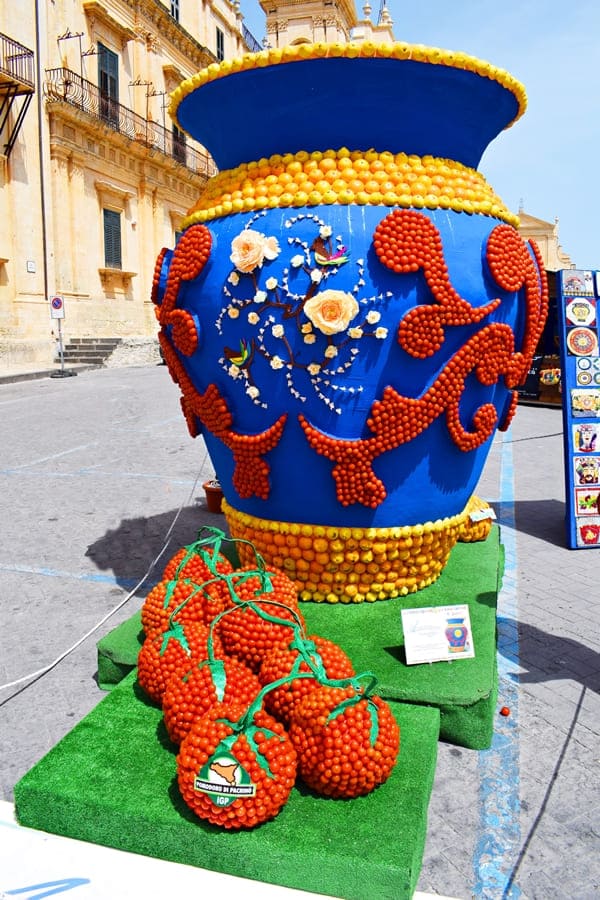




Panoramic viewpoints to observe the Infiorata from above
After observing the sketches of the Infiorata walking along Via Nicolaci, it is also possible to observe the floral carpet from above. To do this, you can take advantage of the bell towers and terraces of the nearby churches of San Carlo al Corso (situated in Corso Vittorio Emanuele) and Montevergini (in Via Cavour).
Another exceptional location from which you can observe the Flower Festival from above is that of the famous balconies of Palazzo Nicolaci. In addition to having an excellent view of the floral carpet designs, it is also an opportunity to see up close the most beautiful baroque balconies in the world.

Infiorata di Noto seen from above, from the terraces of the church of San Carlo al Corso




The Infiorata seen from the balconies of Palazzo Nicolaci

A balcony of Palazzo Nicolaci
What to see in Noto
Whether there is the Infiorata or not, Noto deserves to be visited and is one of the must-see places in South Eastern Sicily.
Noto has very ancient origins. The ancient Sicilians called it Neas, the Greeks Neaton, the Romans Netum and finally the Arabs gave it the name of Noto. In ancient times, however, the town wasn’t located where it is today. Following the disastrous earthquake of January 11th 1693, which devastated the Val di Noto, razing all the inhabited areas of the territory, including Noto, the town was rebuilt in a safer and wider place. For the reconstruction, the best architects were called, who succeeded in creating towns that were more beautiful than expected. It was decided to reconstruct Noto using local stone, a light-coloured and calcareous material. However, the course of time has made this honey-colored stone tending to pink, giving the buildings a greater evocative effect.
The layout of the town was designed with main roads running from east to west, thus following the course of the sun. Entering the historic centre of Noto from the east, you will encounter the Porta Reale. It was built on the occasion of the visit of the Bourbon king Ferdinand II, ruler of the Kingdom of the Two Sicilies.

Porta Reale
Let’s get into the historic centre of Noto
Once past the Porta Reale, you enter the main street of the town, Corso Vittorio Emanuele. Walking along this street full of bars and clubs, where you can sit at the tables surrounded by the Baroque of Noto, you bump into all the main attractions of the Syracusan town.
A few metres from the Porta Reale, you can see Piazza Immacolata. In addition to several bars, here stands the church of San Francesco d’Assisi all’Immacolata, a Baroque masterpiece flanked by the former Franciscan convent, which stands on a staircase. In the centre of the square there is a fountain. Looking at the side of the church of San Francesco d’Assisi all’Immacolata, we see the back of the Convent of the Holy Saviour with its characteristic jealousie windows.

Piazza Immacolata
Continuing to walk along Corso Vittorio Emanuele, on the opposite side you find the church and the former cloistered Convento di Santa Chiara. The interior of the Church of Santa Chiara is richly decorated with puttos and stuccos and is considered one of the greatest examples of Baroque style in Sicily. It has an ovoid-shaped plant, with 12 columns on the sides, on which we can see the statues of the twelve Apostles.


Church of Santa Chiara
After seeing the church, you can also visit the attached former Convent of the Poor Clares and go up to its panoramic terrace, from which you can see one of the beautiful panoramic views of Noto.
Piazza del Municipio: the heart of Noto
Basilica of the Holy Saviour
Continuing slightly along Corso Vittorio Emanuele, we come across the heart of the historic centre of Noto. On the opposite side from the church of Santa Chiara you can see the Basilica of the Holy Savior, connected to the complex of the homonymous former Benedictine Convent.
The entire complex was built in the 18th century. While the convent is the second largest baroque style building in Sicily (after the Benedictine Monastery of Catania), the Basilica of the Holy Saviour mixes baroque elements of the decorations inside with the neoclassical style of the facade. The interior of the Basilica has turquoise blue stuccoes and a frescoed vault with various scenes from the life of Christ. The richness of the decorations is due to the fact that the convent housed the daughters of noble Noto families and others, who took their vows or were forced to do so to escape poverty. At the time only the sons inherited the wealth of their fathers.
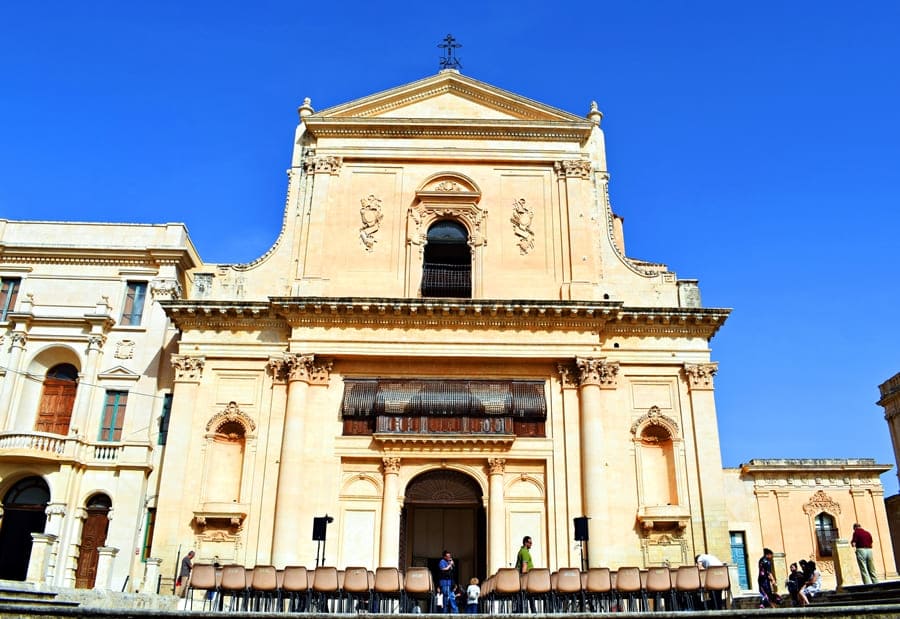

Basilica of the Holy Saviour
Over time, the Convent was converted into the seat of the Seminary of the Diocese of Noto. You can visit only some areas and climb the bell tower, where you can admire the town from above. Furthermore, it was chosen as location for some scenes of the film Storia di una Capinera by Zeffirelli.
Noto Cathedral
While going out from the Basilica of the Holy Saviour, it is possible to admire the imposing Cathedral of San Nicolò, the most important place of worship in Noto. It stands on an eighteenth-century staircase with three ramps. Its facade, built with local limestone, has neoclassical elements and two side towers. Above the central door stands the inscription SPQN (Senatus PopulusQue Netinus).
The Cathedral of San Nicolò was built between 1694 and 1703. Over time it has undergone various changes until the construction of the dome in the 19th century. In 1996 it suffered a devastating collapse. It had suffered structural damage following the earthquake of December 13th, 1990. In addition to this, due to a structural defect in the columns of the central nave, this led to the collapse of the central nave itself and of the one on the right, dragging down the dome. After a long and meticulous reconstruction work, the Cathedral was consecrated by Pope Benedict XVI in 2012.
Inside you can see various works of art dating back to Ancient Noto, including the sixteenth-century shrine containing the remains of San Corrado Confalonieri, patron Saint of the town.



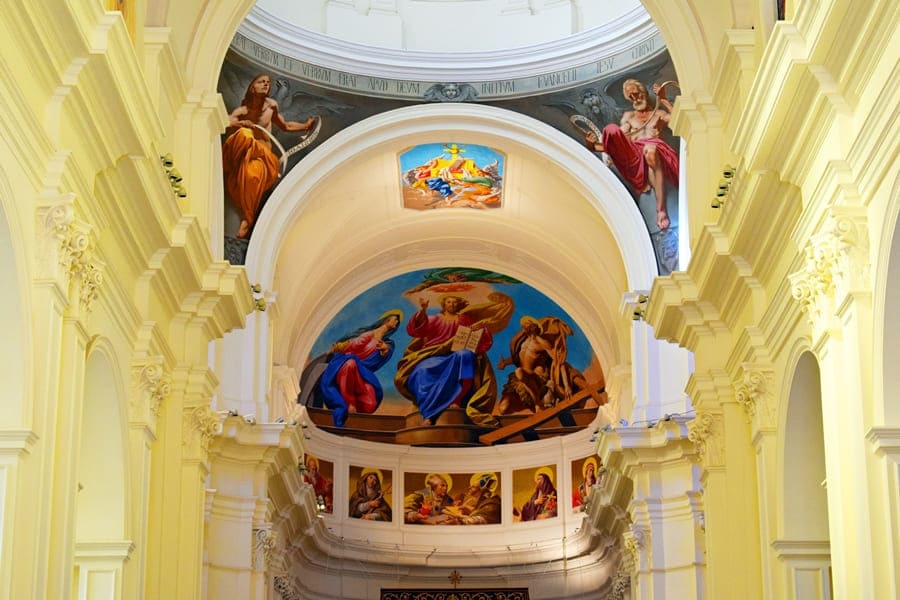
Noto Cathedral
Palazzo Ducezio
Opposite the Cathedral you see Palazzo Ducezio, the seat of the town hall of Noto. It was built between 1746 and 1830 and proves the use of the Baroque style outside of religious buildings and noble palaces. The upper floor was built later, in the first half of the 20th century.
The lower floor has a colonnade with Ionic capitals, while the upper one has thirteen large windows. Inside you can visit the Room of Mirrors paying a ticket of 2 euros. The room is furnished with Louis XV style furniture and 19th-century gilded mirrors. On the ceiling you can admire the frescoed Neas Foundation by the Sicilian king Ducezio, to whom the building is dedicated.

Palazzo Ducezio
Palazzo Nicolaci
Taking up the path along Corso Vittorio Emanuele, you come across the Church of San Carlo al Corso. It’s worth a stop, especially to climb the two terraces, from which you can enjoy a stunning view over the whole town.


Church of San Carlo al Corso


Panoramic view from the terraces of the Church of San Carlo al Corso
Opposite this church there is Via Nicolaci, where the famous balconies of Palazzo Nicolaci overlook. This palace belonged to the Nicolaci family, Princes of Villadorata. Originally this family was not noble. They owned various fiefdoms and were responsible for the management of tuna traps along the coast. They got so rich with this activity that they were able to buy several baronial titles and the title of Princes of Villadorata. Those were the years of the reconstruction after the great earthquake and to celebrate their greatness and the title of acquired Princes, the Nicolaci family decided to build this imposing palace.




Baroque balconies of Palazzo Nicolaci

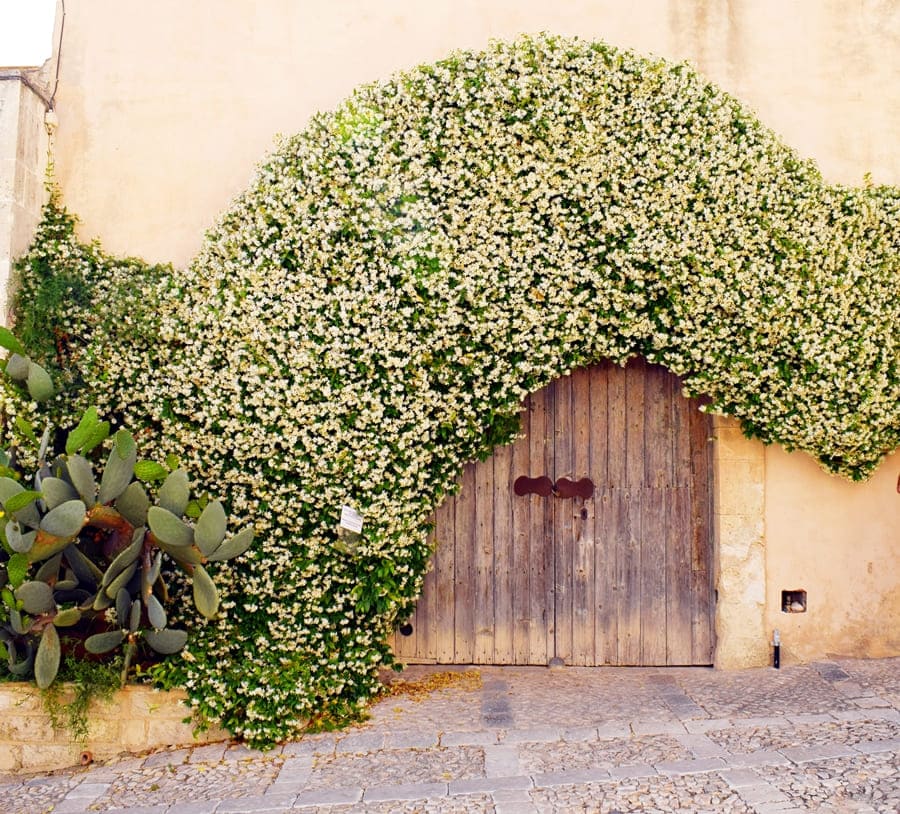
Courtyard of Palazzo Nicolaci
It is a very large complex. Today it houses the Municipal Library on the ground floor, a luxury hotel in a wing and various apartments of the Nicolaci family, some of which can be visited. In the visitable area, it is possible to see various rooms: among others, the Prince’s study; the bedroom facing north, so that the sun didn’t enter the room before noon; the tea room and the yellow room, used by women for conversation; the most striking room is without doubt the Ball Room. The latter is striking for its frescoed walls in shades of blue and red and the ceiling with the allegory of Apollo’s Chariot chasing the Aurora in the centre.


Ball Room
Piazza XVI Maggio
Continuing on Corso Vittorio Emanuele, you arrive in Piazza XVI Maggio. In the centre of the square, you can see Villa d’Ercole, with the eighteenth-century fountain of the same name. The square is dominated by the church of San Domenico, a baroque church with a convex façade facing the street. Opposite the church, there’s the municipal theatre “Tina di Lorenzo”.


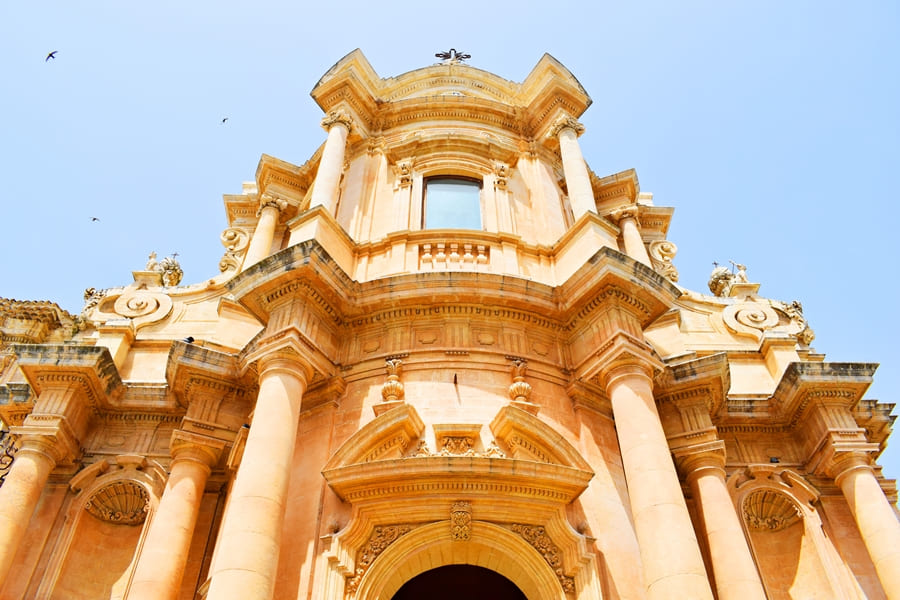

“Tina di Lorenzo” theatre
Obviously those listed are only the main attractions of Noto. Walking through the historic centre, it is possible to come across many other churches and noble buildings in Baroque style. The ideal would be to wander aimlessly and discover them little by little.















Leave A Reply